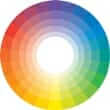Background
- Color therapy uses colors for their proposed healing abilities to treat emotional and physical disturbances. Changing the colors of clothes or home or office décor or visualizing different colors may be recommended. Color therapy is based on the idea that different colors evoke different responses in people. For example, some colors are considered to be stimulating, whereas others may be soothing. Some color therapists assert that they can read and alter the colors of people's auras. In traditional Ayurvedic medicine, different colors are associated with different chakras, or energy centers.
- Color, light, or phototherapy using single or mixed colors, sometimes from a laser, may be shined on the whole body or on particular chakras. The Luscher Color Testâ„¢ is said to indicate mood and personality. Silks colored with natural dyes, solarized water, color cards, or a light box or lamp with colored filters may be included as part of treatment. In addition, meditation and breathing exercises may be performed during color therapy.
- Ocular light therapy, which projects light through colored filters and into the eyes, is sometimes used in people with psychological disorders. Colored light therapy, colorpuncture, and chromopressure are newer techniques.
- Scientific evidence is lacking for color therapy. Although color therapy has been suggested for many conditions, and it has been used in some hospitals, its safety and effectiveness have not been thoroughly studied.
References
- Anderson J. The effect of colour on the severity of migraine symptoms. Brain/Mind Bull 1990;4(15):1.
- Barber CF. The use of music and colour theory as a behaviour modifier. Br J Nurs 1999;8(7):443-448.
View Abstract - Cocilovo A. Colored light therapy: overview of its history, theory, recent developments and clinical applications combined with acupuncture. Am J Acupunct 1999;27(1-2):71-83.
View Abstract - Deppe A. Ocular light therapy: a case study. Aust J Holist Nurs 2000;7(1):41.
View Abstract - Ebbesen F, Agati G, Pratesi R. Phototherapy with turquoise versus blue light. Arch Dis Child Fetal Neonatal Ed. 2003 Sep;88(5):F430-1. PMID: 12937051
View Abstract - Ebbesen F, Madsen P, Stovring S, et al. Therapeutic effect of turquoise versus blue light with equal irradiance in preterm infants with jaundice. Acta Paediatr. 2007 Jun;96(6):837-41.
View Abstract - Evans BJ, Patel R, Wilkins AJ, et al. A review of the management of 323 consecutive patients seen in a specific learning difficulties clinic. Ophthalmic Physiol Opt. 1999 Nov;19(6):454-66.
View Abstract - Jones JE, Kassity N. Varieties of alternative experience: complementary care in the neonatal intensive care unit. Clin Obstet Gynecol. 2001 Dec;44(4):750-68.
View Abstract - Maher CG. Effective physical treatment of chronic low back pain. Orthop Clin North Am 2004;Jan, 35(1):57-64.
View Abstract - Ohara M, Kawashima Y, Kitajima S, et al. Inhibition Of lung metastasis of B16 melanoma cells exposed to blue light in mice. Int J Molecular Medicine 2002;10(6):701-705.
View Abstract - West RW, Penisten DK. The effect of color on light-induced seizures: a case report. Optom Vis Sci. 1996 Feb;73(2):109-13.
View Abstract - Wileman SM, Eagles JM, Andrew JE, et al. Light therapy for seasonal affective disorder in primary care: randomized controlled trial. Br J Psychiatry. 2001 Apr;178:311-6.
View Abstract - Wohlfarth H, Schultz A. The effect of colour psychodynamic environment modification on sound levels in elementary schools. Int J Biosocial Res 2002;(5):12-19.
- Wolffsohn JS, Dinardo C, Vingrys AJ. Benefit of coloured lenses for age-related macular degeneration. Ophthalmic Physiol Opt. 2002 Jul;22(4):300-11.
View Abstract - Zifkin BG, Inoue Y. Visual reflex seizures induced by complex stimuli. Epilepsia. 2004;45 Suppl 1:27-9.
View Abstract







